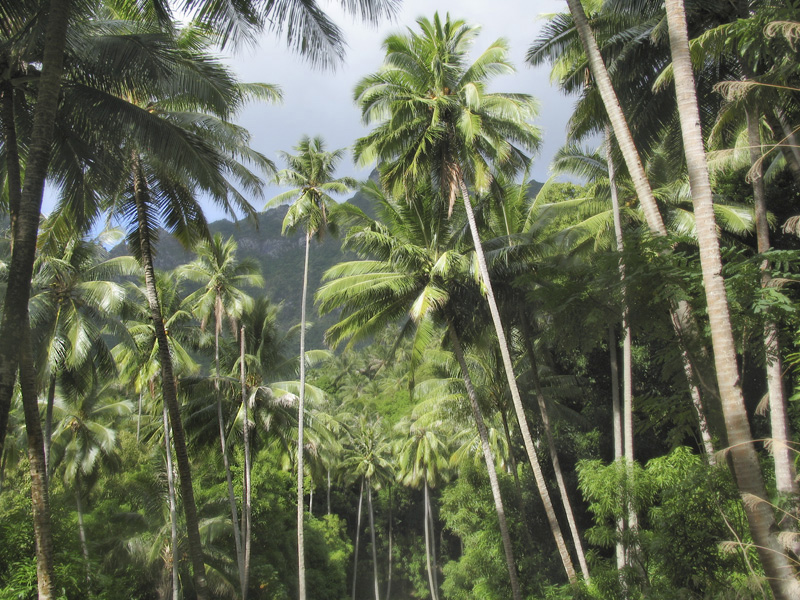
French Polynesia
My big cruise through the Marquesas Islands

All of the images on this page are photographs that I took during my cruise to the Marquesas Islands - there is no artwork featured here.
Well, believe it or not, I was sent on this cruise to the Marquesas Islands by a generous client who commissioned me to complete a painting of the unusual island of Fatu Hiva. These kinds of things just happen to artists, I guess.
The Marquesas Islands are part of French Polynesia in the South Pacific. They're located a few hundred miles north-east of Tahiti. To reach Fatu Hiva, which has no airport and no accommodations, I had few options but to travel by cruise ship. The cruise lasted two weeks, on the Aranui III, which doubles as a freighter and a cruise ship. It stops at every port in the inhabited islands of the Marquesas, delivering or picking up freight while its passengers enjoy time ashore.

The front half of the ship is dedicated to freight, with two cranes for the loading and offloading of goods. The back half of the ship has accomodations for up to 200 passengers, as well as a pool deck, dining hall, lounge, and other facilities. I enjoyed the cruise very much, and would recommend it highly - you can learn more about the Aranui at its website: Aranui.com.
I first travelled to Tahiti and boarded the ship there. The cruise route took us through the Tuamotu atolls both to and from the Marquesas, so I was able to see a variety of types of islands, both flat and mountainous. The Tuamotu atolls are so lacking in dry acreage that the experience there is almost exclusively about the beach, the water and the coral reef. In contrast, the Marquesas Islands are mountainous, similar to the smaller islands of Hawaii, but with some unique landscape features to set them apart - they're extremely rugged and picturesque, although often lacking the well-developed beaches and reefs to be found in Tahiti or Hawaii.
I took hundreds of photos during my trip, and can't possibly offer everything here, but please enjoy this small sample.
Tahiti
Since I was there primarily to board the ship in the capital, I had little time available on Tahiti, spending less than a day and a half there, but I did manage to get a few nice shots of the island.

Looking back, a view of the capital city of Papeete as my ship departs for the Marquesas.

Looking across the bay toward Tahiti Iti (the smaller, southern end of the island), rainy weather at sunset produced some beautiful atmospherics, including the giant rainbow seen below.

The Tuamotu Atolls
Fakarava and Rangiroa
Fakarava and Rangiroa are the largest among more than 70 atolls in the Tuamotu archipelago. These atolls consist of little more than rings of coral that mark the position of islands that formerly stood above sea-level at some time in the distant past, but which have since descended below the waves because of erosion or subsidence, or both. While the islands themselves are no longer visible, they've left a record of themselves through the remains of their coral reefs, which continue to thrive on the submarine foundations of these extinct islands. The reefs absorb the energy of the incoming surf, and so protect the atoll's interior lagoon, where the water is astonishing calm and clear. Dry land appears in the form of coral sand deposits only a few feet above sea-level and never more than a half-mile wide; nevertheless, several of the atolls feature streets, homes, and even small airports.

A picture-perfect setting along the shore of Fakarava lagoon.

Another scene of tropical perfection, at the lagoon of Rangiroa. Rangiroa is the second-largest atoll in the world, more than 20 miles in diameter, so it's impossible to see across to the far side. Swimming in the pleasantly warm, shallow water here was a sublime experience.



The Aranui at rest in the calm waters of Rangiroa.


Sea-side homes at Fakarava
The Marquesas Islands
Fatu Hiva

My first daylight views of Fatu Hiva.


Onshore at Hanavave, my ultimate destination, at Fatu Hiva. Yep, that's a soccer field in the foreground. The valley is famous for its highly unusual rock formations. Hanavave is widely regarded as the most beautiful location in the South Pacific - but its beauty is strange, as if the place were still haunted by the wrathful gods of Polynesia, whose faces seem to appear in the bizarre rock formations that overshadow the island. Several of them are disturbingly reminiscent of the fearsome, stone Tiki idols that still stand watch over ancient Polynesian temples throughout the islands.

Coconut jungle in the back of Hanavave Valley. I've never seen taller, fuller, healthier coconut palms in such wild abundance as in the vast groves to be found in the Marquesas. The harvest of coconut meat is one of the primary sources of income in the islands.

The big show at Hanavave is a display of warm color on the valley at sunset.
Hiva Oa


Tahuata

Above and below: Offshore from a secluded beach at the island of Tahuata.

Ua Pou

The Lost World. Jagged, volcanic spires cap the summit of Ua Pou, arguably the most remarkable island in the Marquesas. Totally prehistoric. The "pterodactyl" flying overhead is actually a Great Frigate-bird, one of the larger sea-birds to be found in the islands.

An alternate view of Ua Pou. Volcanic spires like these occur all across the island.


Ua Huka

Moody morning weather at the small island of Ua Huka.

Smooth, green slopes and rugged cliffs characterize Ua Huka's distinctive landscape.

Sunset near Hiva Oa.